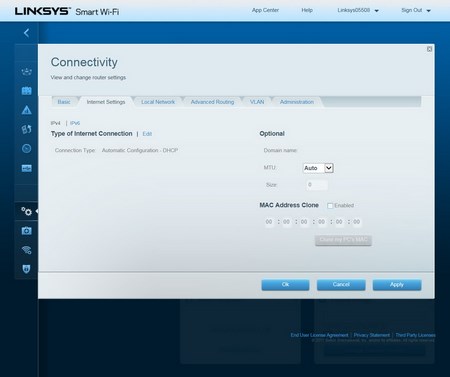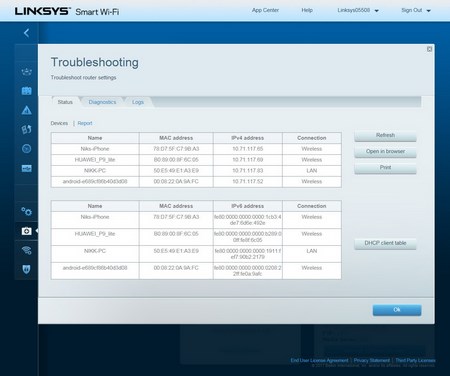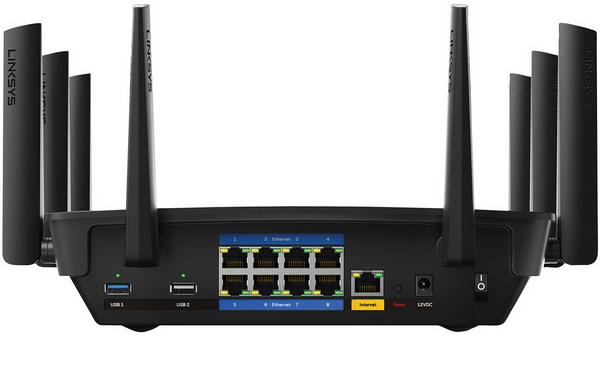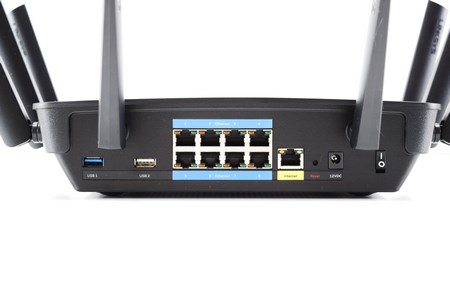INTRODUCTION

Even though as we've pointed out numerous times in our past reviews wired connectivity is pretty much the best one can do (at least not currently) both in terms of performance and security there's simply no denying that wireless connectivity is much more convenient. Because of that as expected really manufacturers are always looking for new and innovative ways to improve the performance and signal strength/range of their wireless network devices. Several semiconductor manufacturers like Broadcom, Marvell and Qualcomm are always releasing improved CPUs and wireless chipsets which also make use of multiple bands so as you all know in recent years we've seen many modem/routers using both 2.4GHz and 5GHz bands. Still it wasn't until last year really that the more powerful AC5300/5400 models were introduced in the market featuring one 2.4GHz band and two 5GHz bands and one of them was the Linksys EA9500 MAX-STREAM AC5400 MU-MIMO Gigabit Router.
The Linksys brand has pioneered wireless connectivity since its inception in 1988 with its leading innovation and engineering strategies, and best-in-class technology, design, and customer service. Linksys enables a connected lifestyle for people at home, at work and on the move, and with its award-winning products, simplifies home control, entertainment, security and Internet access through innovative features and a growing application and partner ecosystem. Linksys is part of Belkin International.
The EA9500 MAX-STREAM AC5400 MU-MIMO Gigabit Router by Linksys is a tri-band quad-stream router which outputs a combined Wi-Fi bandwidth of up to 5333 megabits per second (thus belongs in the brand new AC5400 category). To achieve that extremely high number the EA9500 features two 5GHz bands each able to output up to 2166.67Mbps (AC2166) and a single 2.4GHz band which tops out at 1000Mbps (N1000). Inside the EA9500 Linksys placed Broadcom's BCM4709C0KFEBG dual-core ARM Cortex A9 CPU running at 1.4GHz along with 256MB RAM, 128MB NAND flash and three BCM4366 4x4 radios. The EA9500 also fully supports Beamforming (directs Wi-Fi signal to your wireless devices), MU-MIMO (Multi-User Multiple Input Multiple Output - efficient handling of bandwidth) and Seamless Roaming (automatically switches to the strongest Wi-Fi signal when paired with Max-Stream range extenders). Last but certainly not least the EA9500 comes ready with a total of 8 high performance adjustable Antennas (can't be replaced), 8 Gigabit RJ45 Ethernet ports (Link aggregation is not supported), Gigabit RJ45 WAN port, USB 3.0 port and a USB 2.0 port.
SPECIFICATIONS AND FEATURES

PACKAGING AND CONTENTS
Most of the front is taken by a partial product picture placed right beneath the company logo and a sticker pointing to the 3 year warranty and support and just over the total offered wireless bandwidth.
The product features are also printed on the right side in 4 languages.
All of the product features are explained in depth and showcased at the rear of the box with the help of several pictures and drawings.
Both the package contents and available connections are listed at the base of the box.
Packing is pretty excellent with the EA9500 wrapped inside a plastic bag and placed inside a formed piece of black foam.
Along with the EA9500 and its power adapter and cord you will also get an RJ45 Ethernet cable, documentation CD and a quick start guide.
THE EA9500
With the EA9500 Linksys has released one of the best looking, most solid and largest wireless routers in the market today.
Measuring 318.15mm in length, 264.52mm in width and 66.66mm in height (without the Antennas) the EA9500 rivals the Netgear Nighthawk X6 R8000 in size (however the EA9500 feels much more solid compared to the R8000).
The model name is printed at the top of the router on a small polished surface.
Most of the top is perforated to allow hot air to exit the interior.
There are two round buttons on the right side of the router from where you can turn the wireless signal on/off and enable the WPS function.
The 8 high gain Antennas are fully adjustable but can't be replaced with others.
Every available connection is placed at the rear so from left to right here we see a USB 3.0 port, USB 2.0 port, 8 RJ45 Gigabit Ethernet Ports, RJ45 Gigabit WAN Port, reset button, DC in and an on/off power switch.
The EA9500 sits on 4 round rubber feet and as you can all see the bottom is also perforated.
Once you turn on the EA9500 the front polished section will light up and give you feedback about the current state of the router (activity LEDs).
SMART WI-FI INTERFACE PART 1
Linksys still uses the same user-friendly GUI so the main tab displays the current state of the router.
You can see which devices are currently connected to the EA9500 (both wired and wirelessly) and their internet usage via the network map.









From the Smart WiFi Tools menu you can also enable/disable the guest access control (up to 50 guests), enable/disable parental controls (individual for each device), setup media prioritization (there are several software and game presets already but you can also add your own), perform an internet speed test (not really very reliable since it's the same as the ones we find online) and you can also setup external storage access (setup media server).
SMART WI-FI INTERFACE PART 2






From within the router settings menu you can also adjust some connectivity options, check for updates (manually or automatically), change the type of connection, enable/disable DHCP, setup advanced routing, configure static routing, enable and configure VLAN, enable/disable UPNP and enable/disable HTTPS access.


Linksys has placed a troubleshooting tab via which you can check the status of the router, share info with them, backup and restore its entire configuration, reboot the router, restore previous firmware version, perform diagnostics and read the logs.



Everything that has to do with wireless connectivity (network names, broadcast ID, passwords, WPS, scheduler) is placed under the wireless tab.






As expected from the security tab you can setup the firewall, VPN passthrough, set internet filters, configure DMZ, enable DDNS and finally you can also setup port forwarding (single and/or range).
TESTING METHODOLOGY
Since standalone routers can't directly connect to the internet (unless you have a cable connection which we don't) and thus the modem is responsible for internet speeds the only thing that's left is to test and see how much bandwidth they can offer by directly linking two devices with them. So once again we will be using the networking benchmark by Passmark (v.8), QCheck by Ixia and ATTO 2.47 (since April 2015) to test such devices the same exact way we test Powerline adapters and Modem/Routers. Since we need to test new features and specifications all routers are benchmarked with their highest available wireless standard/band (5GHz in this case). Our systems are outfitted with Kingston HyperX Predator 480GB PCIe SSDs, AC1200 USB 3.0 adapters (we received AC1900 models but so far our results have been somewhat inconclusive in order to replace our AC1200 with them) and CAT7 cables and are placed 15m away from the router with 3 concrete walls between them while each test is repeated a total of 6 times after which the average scores are recorded into our charts. Both systems have Windows 7 Ultimate SP1 installed with all the updates until the 23rd of June 2017.
We’ve received several requests by some of you to also measure power consumption when testing modem/routers and although differences are not that great between similar models we decided to do so (average power consumption during tests is placed in our charts). Also again after many requests from April 2017 we will also do our best to measure wired USB performance of any modem/router or standalone router that gets to our lab with the help of Crystal Disk Mark v5.1.2 and a Samsung T1 250GB Portable SSD.
TEST RESULTS





CONCLUSION

With the WRT models Linksys managed to grab the attention of no only professionals and enthusiasts but also regular consumers so we didn’t expect to see something faster from them anytime soon. However the arrival of the EA9500 MAX-STREAM AC5400 MU-MIMO Gigabit Router marks exactly that since it offers by far the best wireless performance we’ve seen to date. The WRT models are still “kings” when it comes to USB performance (as clearly shown in our charts – probably due to the just 256MB RAM used) and they don’t “consume” as much electricity but those two things come I suspect second and third after wireless performance (at least for most users). Size may also be an issue for some people but let’s not get too excited since I really doubt anyone who can afford an ultra-high-end wireless router will have a problem finding room for it. Build quality is not something we care a lot for when we test modem/routers but this is yet another thing the EA9500 seems to have in common with the WRT models.
The Linksys EA9500 MAX-STREAM AC5400 MU-MIMO Gigabit Router is currently if not the fastest wireless router in the market (there are some AC5400 models we haven’t tested) then it’s certainly among the fastest ones and that combined with its 8 RJ45 Gigabit Ethernet ports means we’re talking about the crème de la crème of routers. Because of that its current price tag of USD349.99 inside the USA (Amazon.com) and 273Euros inside the EU (Amazon.co.uk) is more or less justified. Linksys could had certainly made it even better by giving it a higher amount of RAM (which would improve its USB performance) but even without that the EA9500 represents not only the best wireless performance (AC5400 via 8 high-gain Antennas) money can buy today but also the highest wired expandability (thanks to its 8 Gigabit ports) and that’s why it grabs our Platinum Award.

PROS
- Build Quality
- Design
- Second To None Wireless Performance
- AC5400 Technology (Concurrent 802.11n & Dual 802.11ac)
- Features (Beamforming, MU-MIMO And Tri-Band Technology)
- 8 High Gain Antennas
- Smart Web Interface
- 8 Gigabit Ethernet Ports
- USB 3.0 Port & USB 2.0 Port
CONS
- Price (For Some)
- USB Performance (Compared To The WRT Models)

 O-Sense
O-Sense
























.png)

